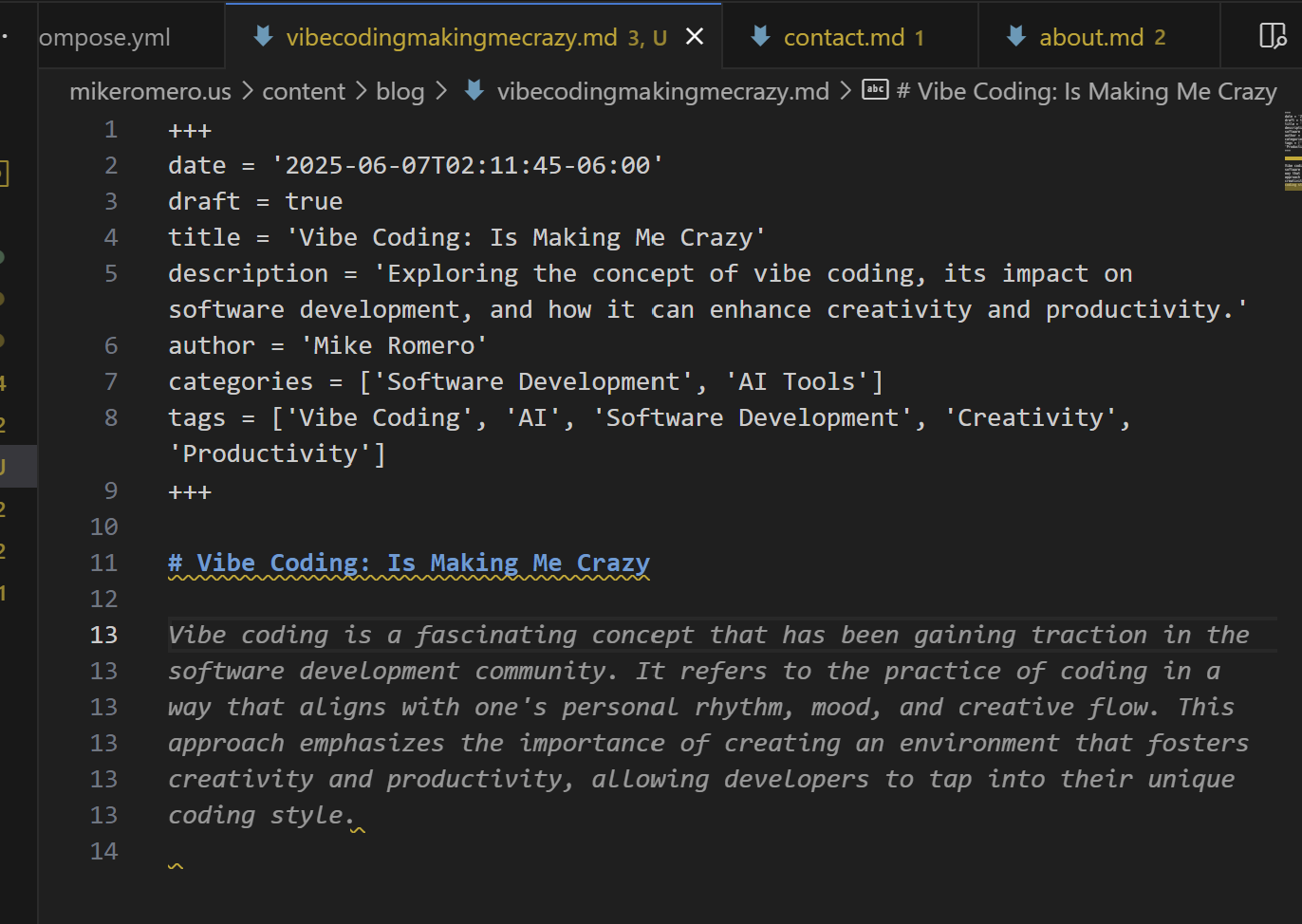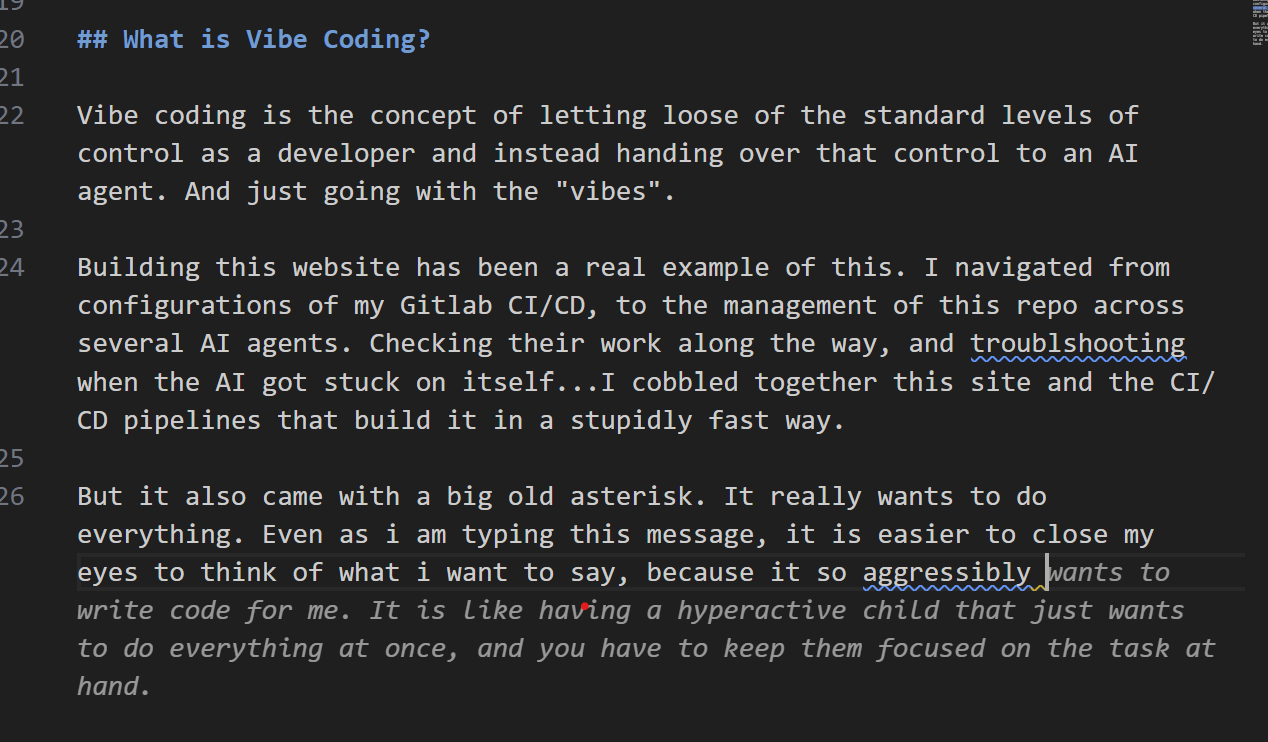Vibe Coding: Is Making Me Crazy
Mike Romero
Vibe Coding: Is Making Me Crazy

The image here and in the title is an interesting one. A fundamental part of my blog is the unique structure i am using. I’m wiring these posts as what I would call “Blog as code”, or using a tool known as hugo to put the blog posts into easily creatable and manageable Markdown files. In other words, I don’t want to spend too much time formatting, and would rather just have a couple of Markdown files that i am managing, put into source control in git, and then automatically deployed out my site.
And as part of this, my development tools are active, which include tools like Autocomplete, suggestion, and agentic workflows. The power of AI is front and center on every post I make.
What is Vibe Coding?
Vibe coding is the concept of letting loose of the standard levels of control as a developer and instead handing over that control to an AI agent to free up your mind. In theory, this should allow you to just sit back, and let the code flow and create an environment of innovation rather than troubleshooting. And just going with the “vibes”.
And the Truth is, it works.
Building this website has been a real example of this. I navigated from configurations of my Gitlab CI/CD, to the management of this repo across several AI agents. Checking their work along the way, and troubleshooting when the AI got stuck on itself…I cobbled together this site and the CI/CD pipelines that build it in a stupidly fast way compared to what my standard professional capability allows for. I was able to focus on the content, the structure, and the design of the site, rather than getting bogged down in the details of how to make it all work.
But it also came with a big old asterisk. It really wants to do everything. Even as i am typing this message, it is easier to close my eyes to think of what i want to say, because it so aggressively…

It is cool and all…but boy, it is a lot. I can’t express how this makes my mind race and reel. Like learning a more powerful programming language that simplifies some esoteric workflow from a past workflow…but for everything. Common speech in markdown, code, and even architectural designs.
The Impact of Vibe Coding
The impact of vibe coding is profound. By relinquishing some control to AI, developers can tap into a wellspring of creativity and innovation. The traditional constraints of coding—debugging, syntax errors, and architectural decisions—fade into the background, allowing for a more fluid and organic development process.
That said, developers aren’t entirely off the hook. While the AI can handle many tasks, it still requires oversight and guidance. We need to step in when the AI encounters challenges or makes decisions that don’t align with the project’s goals—or, as I sometimes put it, when it goes bonkers. Hallucinations and disagreements with the AI are common, especially when the model latches onto a hyper-focused solution that misses the bigger picture.
In my experience, the most significant impact of vibe coding has been on workflows and the dynamics of office conversations and politics. It helps you move faster and think more freely, unburdened by the minutiae of coding—the minor issues that block ideas, the compiler errors that send you hunting through documentation, and the frustration of fighting for rapid iteration. The AI becomes a true collaborator, helping to explore new ideas and approaches without the friction that interpersonal dynamics can sometimes introduce.
At the same time, it can be disorienting. The AI generates suggestions at such a pace that it’s overwhelming to stop and review them all properly. It’s not uncommon to overhear tensions brewing, as some see AI-generated work as chaotic noise to be avoided. Unlike the slow, deliberate crawl of traditional development, vibe coding can feel like a firehose of information demanding to be processed. But the power it unlocks is genuinely awe-inspiring.
Ultimately, vibe coding represents a shift in how we think about software development. It is undeniably part of the future, even if it feels a bit overwhelming in its current form. Software engineering becomes less about simply writing code and more about creating an environment where creativity can thrive and where we can build increasingly advanced applications. As we continue to integrate AI into our workflows, I’m certain we’ll see even more exciting developments—but as I write this, I can’t help feeling a mix of excitement and apprehension about what lies ahead.